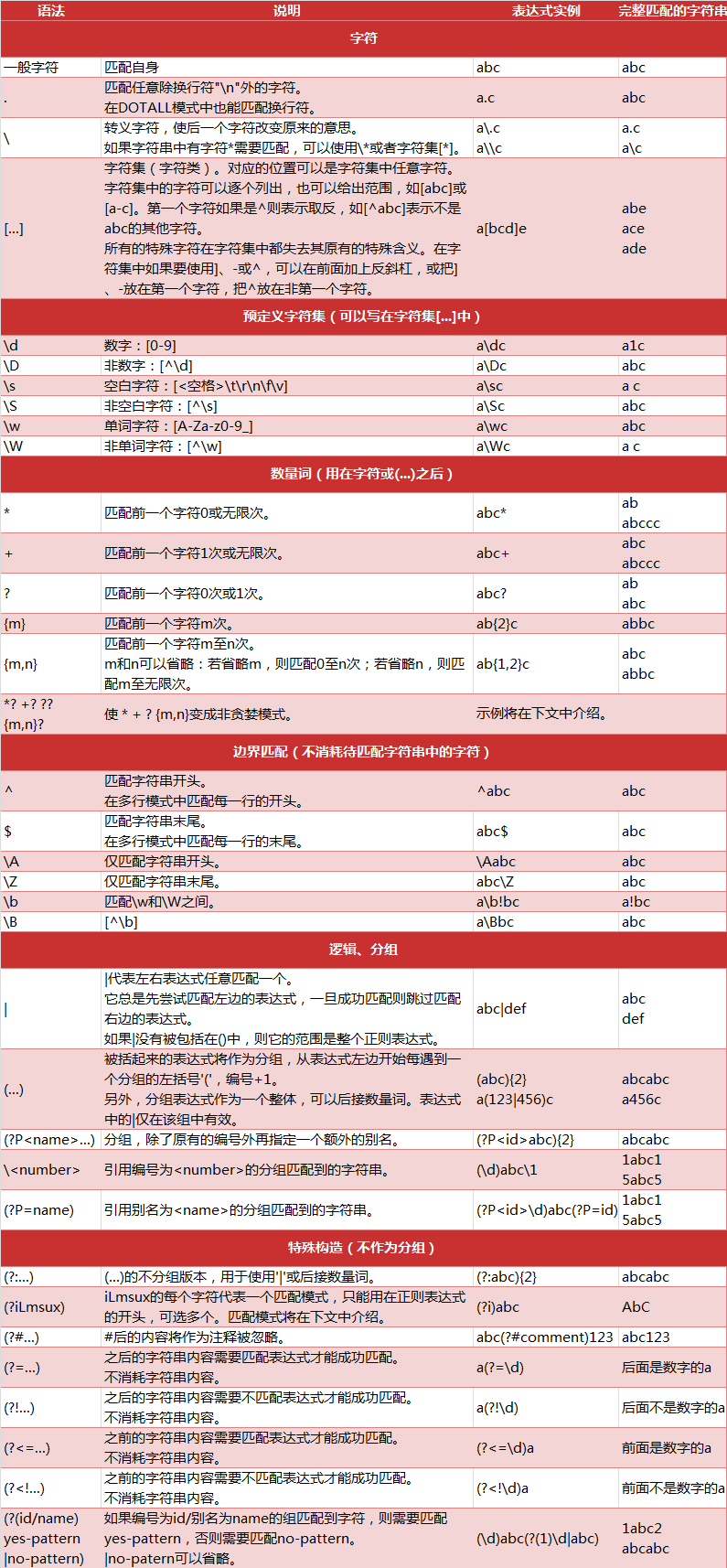面对大量杂乱的代码夹杂文字我们怎样把它提取出来整理呢?下面就开始介绍一个十分强大的工具,正则表达式!
1.了解正则表达式
正则表达式是对字符串操作的一种逻辑公式,就是用事先定义好的一些特定字符、及这些特定字符的组合,组成一个“规则字符串”,这个“规则字符串”用来表达对字符串的一种过滤逻辑。
正则表达式是用来匹配字符串非常强大的工具,在其他编程语言中同样有正则表达式的概念,Python同样不例外,利用了正则表达式,我们想要从返回的页面内容提取出我们想要的内容就易如反掌了。
正则表达式的大致匹配过程是:
- 依次拿出表达式和文本中的字符比较,
- 如果每一个字符都能匹配,则匹配成功;一旦有匹配不成功的字符则匹配失败。
- 如果表达式中有量词或边界,这个过程会稍微有一些不同。
2.正则表达式的语法规则
下面是Python中正则表达式的一些匹配规则,图片资料来自CSDN

3.正则表达式相关注解
(1)数量词的贪婪模式与非贪婪模式
正则表达式通常用于在文本中查找匹配的字符串。Python里数量词默认是贪婪的(在少数语言里也可能是默认非贪婪),总是尝试匹配尽可能多的字符;非贪婪的则相反,总是尝试匹配尽可能少的字符。例如:正则表达式”ab*”如果用于查找”abbbc”,将找到”abbb”。而如果使用非贪婪的数量词”ab*?”,将找到”a”。
注:我们一般使用非贪婪模式来提取。
(2)反斜杠问题
与大多数编程语言相同,正则表达式里使用”\”作为转义字符,这就可能造成反斜杠困扰。假如你需要匹配文本中的字符”\”,那么使用编程语言表示的正则表达式里将需要4个反斜杠”\\\\”:前两个和后两个分别用于在编程语言里转义成反斜杠,转换成两个反斜杠后再在正则表达式里转义成一个反斜杠。
Python里的原生字符串很好地解决了这个问题,这个例子中的正则表达式可以使用r”\\”表示。同样,匹配一个数字的”\\d”可以写成r”\d”。有了原生字符串,妈妈也不用担心是不是漏写了反斜杠,写出来的表达式也更直观勒。
4.Python Re模块
Python 自带了re模块,它提供了对正则表达式的支持。主要用到的方法列举如下
#返回pattern对象 re.compile(string[,flag]) #以下为匹配所用函数 re.match(pattern, string[, flags]) re.search(pattern, string[, flags]) re.split(pattern, string[, maxsplit]) re.findall(pattern, string[, flags]) re.finditer(pattern, string[, flags]) re.sub(pattern, repl, string[, count]) re.subn(pattern, repl, string[, count])
在介绍这几个方法之前,我们先来介绍一下pattern的概念,pattern可以理解为一个匹配模式,那么我们怎么获得这个匹配模式呢?很简单,我们需要利用re.compile方法就可以。例如
pattern = re.compile(r'hello')
在参数中我们传入了原生字符串对象,通过compile方法编译生成一个pattern对象,然后我们利用这个对象来进行进一步的匹配。
另外大家可能注意到了另一个参数 flags,在这里解释一下这个参数的含义:
参数flag是匹配模式,取值可以使用按位或运算符'|'表示同时生效,比如re.I | re.M。
可选值有:
• re.I(全拼:IGNORECASE): 忽略大小写(括号内是完整写法,下同)
• re.M(全拼:MULTILINE): 多行模式,改变'^'和'$'的行为(参见上图)
• re.S(全拼:DOTALL): 点任意匹配模式,改变'.'的行为
• re.L(全拼:LOCALE): 使预定字符类 \w \W \b \B \s \S 取决于当前区域设定
• re.U(全拼:UNICODE): 使预定字符类 \w \W \b \B \s \S \d \D 取决于unicode定义的字符属性
• re.X(全拼:VERBOSE): 详细模式。这个模式下正则表达式可以是多行,忽略空白字符,并可以加入注释。
在刚才所说的另外几个方法例如 re.match 里我们就需要用到这个pattern了,下面我们一一介绍。
注:以下七个方法中的flags同样是代表匹配模式的意思,如果在pattern生成时已经指明了flags,那么在下面的方法中就不需要传入这个参数了。
(1)re.match(pattern, string[, flags])
这个方法将会从string(我们要匹配的字符串)的开头开始,尝试匹配pattern,一直向后匹配,如果遇到无法匹配的字符,立即返回None,如果匹配未结束已经到达string的末尾,也会返回None。两个结果均表示匹配失败,否则匹配pattern成功,同时匹配终止,不再对string向后匹配。下面我们通过一个例子理解一下
# -*- coding: utf-8 -*- #导入re模块 import re # 将正则表达式编译成Pattern对象,注意hello前面的r的意思是“原生字符串” pattern = re.compile(r'hello') # 使用re.match匹配文本,获得匹配结果,无法匹配时将返回None result1 = re.match(pattern,'hello') result2 = re.match(pattern,'helloo CQC!') result3 = re.match(pattern,'helo CQC!') result4 = re.match(pattern,'hello CQC!') #如果1匹配成功 if result1: # 使用Match获得分组信息 print result1.group() else: print '1匹配失败!' #如果2匹配成功 if result2: # 使用Match获得分组信息 print result2.group() else: print '2匹配失败!' #如果3匹配成功 if result3: # 使用Match获得分组信息 print result3.group() else: print '3匹配失败!' #如果4匹配成功 if result4: # 使用Match获得分组信息 print result4.group() else: print '4匹配失败!'
运行结果
hello hello 3匹配失败! hello
匹配分析
1.第一个匹配,pattern正则表达式为'hello',我们匹配的目标字符串string也为hello,从头至尾完全匹配,匹配成功。
2.第二个匹配,string为helloo CQC,从string头开始匹配pattern完全可以匹配,pattern匹配结束,同时匹配终止,后面的o CQC不再匹配,返回匹配成功的信息。
3.第三个匹配,string为helo CQC,从string头开始匹配pattern,发现到 ‘o' 时无法完成匹配,匹配终止,返回None
4.第四个匹配,同第二个匹配原理,即使遇到了空格符也不会受影响。
我们还看到最后打印出了result.group(),这个是什么意思呢?下面我们说一下关于match对象的的属性和方法
Match对象是一次匹配的结果,包含了很多关于此次匹配的信息,可以使用Match提供的可读属性或方法来获取这些信息。
属性:
1.string: 匹配时使用的文本。
2.re: 匹配时使用的Pattern对象。
3.pos: 文本中正则表达式开始搜索的索引。值与Pattern.match()和Pattern.seach()方法的同名参数相同。
4.endpos: 文本中正则表达式结束搜索的索引。值与Pattern.match()和Pattern.seach()方法的同名参数相同。
5.lastindex: 最后一个被捕获的分组在文本中的索引。如果没有被捕获的分组,将为None。
6.lastgroup: 最后一个被捕获的分组的别名。如果这个分组没有别名或者没有被捕获的分组,将为None。
方法:
1.group([group1, …]):
获得一个或多个分组截获的字符串;指定多个参数时将以元组形式返回。group1可以使用编号也可以使用别名;编号0代表整个匹配的子串;不填写参数时,返回group(0);没有截获字符串的组返回None;截获了多次的组返回最后一次截获的子串。
2.groups([default]):
以元组形式返回全部分组截获的字符串。相当于调用group(1,2,…last)。default表示没有截获字符串的组以这个值替代,默认为None。
3.groupdict([default]):
返回以有别名的组的别名为键、以该组截获的子串为值的字典,没有别名的组不包含在内。default含义同上。
4.start([group]):
返回指定的组截获的子串在string中的起始索引(子串第一个字符的索引)。group默认值为0。
5.end([group]):
返回指定的组截获的子串在string中的结束索引(子串最后一个字符的索引+1)。group默认值为0。
6.span([group]):
返回(start(group), end(group))。
7.expand(template):
将匹配到的分组代入template中然后返回。template中可以使用\id或\g、\g引用分组,但不能使用编号0。\id与\g是等价的;但\10将被认为是第10个分组,如果你想表达\1之后是字符'0',只能使用\g0。
下面我们用一个例子来体会一下
# -*- coding: utf-8 -*-
#一个简单的match实例
import re
# 匹配如下内容:单词+空格+单词+任意字符
m = re.match(r'(\w+) (\w+)(?P<sign>.*)', 'hello world!')
print "m.string:", m.string
print "m.re:", m.re
print "m.pos:", m.pos
print "m.endpos:", m.endpos
print "m.lastindex:", m.lastindex
print "m.lastgroup:", m.lastgroup
print "m.group():", m.group()
print "m.group(1,2):", m.group(1, 2)
print "m.groups():", m.groups()
print "m.groupdict():", m.groupdict()
print "m.start(2):", m.start(2)
print "m.end(2):", m.end(2)
print "m.span(2):", m.span(2)
print r"m.expand(r'\g \g\g'):", m.expand(r'\2 \1\3')
### output ###
# m.string: hello world!
# m.re:
# m.pos: 0
# m.endpos: 12
# m.lastindex: 3
# m.lastgroup: sign
# m.group(1,2): ('hello', 'world')
# m.groups(): ('hello', 'world', '!')
# m.groupdict(): {'sign': '!'}
# m.start(2): 6
# m.end(2): 11
# m.span(2): (6, 11)
# m.expand(r'\2 \1\3'): world hello!
(2)re.search(pattern, string[, flags])
search方法与match方法极其类似,区别在于match()函数只检测re是不是在string的开始位置匹配,search()会扫描整个string查找匹配,match()只有在0位置匹配成功的话才有返回,如果不是开始位置匹配成功的话,match()就返回None。同样,search方法的返回对象同样match()返回对象的方法和属性。我们用一个例子感受一下
#导入re模块 import re # 将正则表达式编译成Pattern对象 pattern = re.compile(r'world') # 使用search()查找匹配的子串,不存在能匹配的子串时将返回None # 这个例子中使用match()无法成功匹配 match = re.search(pattern,'hello world!') if match: # 使用Match获得分组信息 print match.group() ### 输出 ### # world
(3)re.split(pattern, string[, maxsplit])
按照能够匹配的子串将string分割后返回列表。maxsplit用于指定最大分割次数,不指定将全部分割。我们通过下面的例子感受一下。
import re pattern = re.compile(r'\d+') print re.split(pattern,'one1two2three3four4') ### 输出 ### # ['one', 'two', 'three', 'four', '']
(4)re.findall(pattern, string[, flags])
搜索string,以列表形式返回全部能匹配的子串。我们通过这个例子来感受一下
import re pattern = re.compile(r'\d+') print re.findall(pattern,'one1two2three3four4') ### 输出 ### # ['1', '2', '3', '4']
(5)re.finditer(pattern, string[, flags])
搜索string,返回一个顺序访问每一个匹配结果(Match对象)的迭代器。我们通过下面的例子来感受一下
import re pattern = re.compile(r'\d+') for m in re.finditer(pattern,'one1two2three3four4'): print m.group(), ### 输出 ### # 1 2 3 4
(6)re.sub(pattern, repl, string[, count])
使用repl替换string中每一个匹配的子串后返回替换后的字符串。
当repl是一个字符串时,可以使用\id或\g、\g引用分组,但不能使用编号0。
当repl是一个方法时,这个方法应当只接受一个参数(Match对象),并返回一个字符串用于替换(返回的字符串中不能再引用分组)。
count用于指定最多替换次数,不指定时全部替换。
import re pattern = re.compile(r'(\w+) (\w+)') s = 'i say, hello world!' print re.sub(pattern,r'\2 \1', s) def func(m): return m.group(1).title() + ' ' + m.group(2).title() print re.sub(pattern,func, s) ### output ### # say i, world hello! # I Say, Hello World!
(7)re.subn(pattern, repl, string[, count])
返回 (sub(repl, string[, count]), 替换次数)。
import re
pattern = re.compile(r'(\w+) (\w+)')
s = 'i say, hello world!'
print re.subn(pattern,r'\2 \1', s)
def func(m):
return m.group(1).title() + ' ' + m.group(2).title()
print re.subn(pattern,func, s)
### output ###
# ('say i, world hello!', 2)
# ('I Say, Hello World!', 2)
5.Python Re模块的另一种使用方式
在上面我们介绍了7个工具方法,例如match,search等等,不过调用方式都是 re.match,re.search的方式,其实还有另外一种调用方式,可以通过pattern.match,pattern.search调用,这样调用便不用将pattern作为第一个参数传入了,大家想怎样调用皆可。
函数API列表
match(string[, pos[, endpos]]) | re.match(pattern, string[, flags]) search(string[, pos[, endpos]]) | re.search(pattern, string[, flags]) split(string[, maxsplit]) | re.split(pattern, string[, maxsplit]) findall(string[, pos[, endpos]]) | re.findall(pattern, string[, flags]) finditer(string[, pos[, endpos]]) | re.finditer(pattern, string[, flags]) sub(repl, string[, count]) | re.sub(pattern, repl, string[, count]) subn(repl, string[, count]) |re.sub(pattern, repl, string[, count])
具体的调用方法不必详说了,原理都类似,只是参数的变化不同。小伙伴们尝试一下吧~
小伙伴们加油,即使这一节看得云里雾里的也没关系,接下来我们会通过一些实战例子来帮助大家熟练掌握正则表达式的。
 Pythonを使用した科学コンピューティングでアレイはどのように使用されていますか?Apr 25, 2025 am 12:28 AM
Pythonを使用した科学コンピューティングでアレイはどのように使用されていますか?Apr 25, 2025 am 12:28 AMArraysinpython、特にvianumpy、arecrucialinscientificComputing fortheirefficienty andversitility.1)彼らは、fornumericaloperations、data analysis、andmachinelearning.2)numpy'simplementation incensuresfasteroperationsthanpasteroperations.3)arayableminablecickick
 同じシステムで異なるPythonバージョンをどのように処理しますか?Apr 25, 2025 am 12:24 AM
同じシステムで異なるPythonバージョンをどのように処理しますか?Apr 25, 2025 am 12:24 AMPyenv、Venv、およびAnacondaを使用して、さまざまなPythonバージョンを管理できます。 1)Pyenvを使用して、複数のPythonバージョンを管理します。Pyenvをインストールし、グローバルバージョンとローカルバージョンを設定します。 2)VENVを使用して仮想環境を作成して、プロジェクトの依存関係を分離します。 3)Anacondaを使用して、データサイエンスプロジェクトでPythonバージョンを管理します。 4)システムレベルのタスク用にシステムPythonを保持します。これらのツールと戦略を通じて、Pythonのさまざまなバージョンを効果的に管理して、プロジェクトのスムーズな実行を確保できます。
 標準のPythonアレイでnumpyアレイを使用することの利点は何ですか?Apr 25, 2025 am 12:21 AM
標準のPythonアレイでnumpyアレイを使用することの利点は何ですか?Apr 25, 2025 am 12:21 AMnumpyarrayshaveveraladvantages-averstandardpythonarrays:1)thealmuchfasterduetocベースのインプレンテーション、2)アレモレメモリ効率、特にlargedatasets、および3)それらは、拡散化された、構造化された形成術科療法、
 アレイの均質な性質はパフォーマンスにどのように影響しますか?Apr 25, 2025 am 12:13 AM
アレイの均質な性質はパフォーマンスにどのように影響しますか?Apr 25, 2025 am 12:13 AMパフォーマンスに対する配列の均一性の影響は二重です。1)均一性により、コンパイラはメモリアクセスを最適化し、パフォーマンスを改善できます。 2)しかし、タイプの多様性を制限し、それが非効率につながる可能性があります。要するに、適切なデータ構造を選択することが重要です。
 実行可能なPythonスクリプトを作成するためのベストプラクティスは何ですか?Apr 25, 2025 am 12:11 AM
実行可能なPythonスクリプトを作成するためのベストプラクティスは何ですか?Apr 25, 2025 am 12:11 AMcraftexecutablepythonscripts、次のようになります
 numpyアレイは、アレイモジュールを使用して作成された配列とどのように異なりますか?Apr 24, 2025 pm 03:53 PM
numpyアレイは、アレイモジュールを使用して作成された配列とどのように異なりますか?Apr 24, 2025 pm 03:53 PMnumpyarraysarasarebetterfornumeroperations andmulti-dimensionaldata、whilethearraymoduleissuitable forbasic、1)numpyexcelsinperformance and forlargedatasentassandcomplexoperations.2)thearraymuremememory-effictientivearientfa
 Numpyアレイの使用は、Pythonで配列モジュール配列の使用と比較してどのように比較されますか?Apr 24, 2025 pm 03:49 PM
Numpyアレイの使用は、Pythonで配列モジュール配列の使用と比較してどのように比較されますか?Apr 24, 2025 pm 03:49 PMNumPyArraySareBetterforHeavyNumericalComputing、whilethearrayarayismoreSuitableformemory-constrainedprojectswithsimpledatatypes.1)numpyarraysofferarays andatiledance andpeperancedatasandatassandcomplexoperations.2)thearraymoduleisuleiseightweightandmemememe-ef
 CTypesモジュールは、Pythonの配列にどのように関連していますか?Apr 24, 2025 pm 03:45 PM
CTypesモジュールは、Pythonの配列にどのように関連していますか?Apr 24, 2025 pm 03:45 PMctypesallowsinging andmanipulatingc-stylearraysinpython.1)usectypestointerfacewithclibrariesforperformance.2)createc-stylearraysfornumericalcomputations.3)passarraystocfunctions foreffientientoperations.how、how、becuutiousmorymanagemation、performanceo


ホットAIツール

Undresser.AI Undress
リアルなヌード写真を作成する AI 搭載アプリ

AI Clothes Remover
写真から衣服を削除するオンライン AI ツール。

Undress AI Tool
脱衣画像を無料で

Clothoff.io
AI衣類リムーバー

Video Face Swap
完全無料の AI 顔交換ツールを使用して、あらゆるビデオの顔を簡単に交換できます。

人気の記事

ホットツール

SAP NetWeaver Server Adapter for Eclipse
Eclipse を SAP NetWeaver アプリケーション サーバーと統合します。

DVWA
Damn Vulnerable Web App (DVWA) は、非常に脆弱な PHP/MySQL Web アプリケーションです。その主な目的は、セキュリティ専門家が法的環境でスキルとツールをテストするのに役立ち、Web 開発者が Web アプリケーションを保護するプロセスをより深く理解できるようにし、教師/生徒が教室環境で Web アプリケーションを教え/学習できるようにすることです。安全。 DVWA の目標は、シンプルでわかりやすいインターフェイスを通じて、さまざまな難易度で最も一般的な Web 脆弱性のいくつかを実践することです。このソフトウェアは、

SublimeText3 Mac版
神レベルのコード編集ソフト(SublimeText3)

メモ帳++7.3.1
使いやすく無料のコードエディター

VSCode Windows 64 ビットのダウンロード
Microsoft によって発売された無料で強力な IDE エディター

ホットトピック
 7704
7704 15
15 1640
1640 14
14 1393
1393 52
52 1288
1288 25
25 1231
1231 29
29


